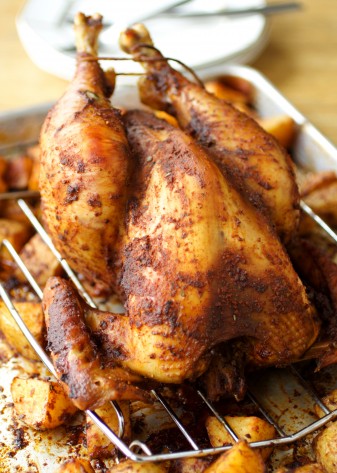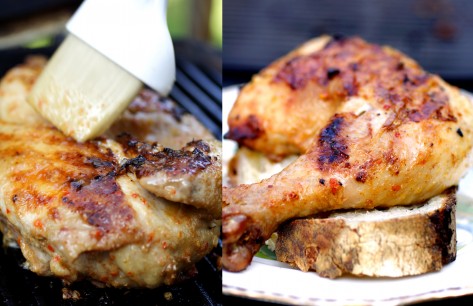The Chicken Chronicles: Heritage Breeds Versus Modern Hybrids, and Roasted Versus Grilled

Without intending to write a follow-up to my last posting on heirloom seeds, I’ve done so with this story, which deals with the other h word—heritage breeds.
A couple of weeks ago, after having done the work of making a double batch of David Leite’s Amped-Up Red Pepper Paste as well as his Piri-Piri Sauce, both in his cookbook The New Portuguese Table, I decided to make two poultry recipes that would highlight their flavors.
I started with Leite’s Quick Weekday Roast Chicken with Potaotes. The chicken is slathered, under the skin and on top, with the red pepper paste, inserted in a hot 425-degree oven and roasted for thirty-five minutes, and then for an additional fifty minutes to one hour at 350 degrees.
I followed the instructions to a tee, as I usually do when trying a recipe for the first time, but the result wasn’t good. The seasoning was great, and the breast meat tender yet firm, but the thighs and legs, though very flavorful, were also very tough. I berated myself, not David Leite.
I had used a heritage breed of chicken called the Naked Neck Turken. I puchased two Naked Neck Turkens from the Perry Family Farm, run by my friend James Perry. The sizable Naked Neck Turkens, all roosters, had been allowed to run freely on his farm, and were twenty-eight weeks old when slaughtered.
In contast, the white Cornish cross, a modern hybrid and the current standard meat bird, grows much more quickly; it is generally processed between six weeks and twelve weeks of age—the shorter time being typical at commercial chicken operations, the longer at a small family farms where the chickens are likely to be on pasture as well as grain, and thus grow more slowly.
I’ve seen white Cornish crosses on pasture at small, diversified farms in Vermont. Even with plentiful pasture to roam, they walk little or not at all. (Their pronounced breast, for which they’ve been bred, makes them top heavy and off balance.) There is something depressing and deeply saddening about their unchickenlike behavior.
Besides their difficulty in walking, there are other potential heath problems. Julie Iffland of Highfields Farm in Randolph, Vermont, who slaughters her meat birds at twelve weeks of age, told me that her flocks of white Cornish crosses don’t seem to have the immune system—the same “pluck”—that her heritage layers do; when a Cornish cross gets a scrape, it can easily become infected and turn septic.
James had told me the age of the Naked Neck Turkens before I made Leite’s roast my , so I can’t blame him either. The real problem is that I went into a zombie must-follow-the-recipe, must-follow-the-recipe mode without considering that modern cookbooks are written for modern food.
Old-fashioned “slow” food requires old-fashioned cooking methods, and when it comes to poultry, low and slow cooking is helpful. Cooking heritage chickens, particuarly ones that have been allowed to roam for a good long while, requires more work on the cook’s part in that a bit of research is required. You will not find answers in today’s cookbooks or conventional cooking magazines. It is very easy, though, to find methods for cooking heritage chickens in old cookbooks, online, and in magazines like Mother Earth.
The huge difference in tenderness between the breast and legs in my roasted, twenty-eight-week-old bird made me think of the chicken walking about here and there and was a reminder of how as a culture we’ve lost the knowledge of how to prepare chickens that are allowed to be chickens. We would never think of preparing a beef tenderloin the same way as a shank, a cut from the cow’s legs. Why not think think of heritage chickens, particularly older, heritage chickens, the same way?
My second poultry experiment from The New Portuguese Table—Grilled Chicken Slathered in Hot Sauce (shown below)—utilized the Piri-Piri Sauce I’d made. From experiment number one, I knew that grilling, a relatively fast cooking method, would not be a good choice for Naked Neck Turken#2 sitting in my freezer.

So, even though I don’t like the idea of buying Cornish crosses for all the reasons stated above, for the recipe I bought one from Misty Knoll Farms, a Vermont chicken and turkey farm that processes their naturally raised chickens at seven weeks of age. Though the meat was juicy and tender and cooked perfectly following Leite’s instructions, overall the meat, particuarly the dark meat, was not as flavorful as the Naked Neck Turken. But this, in the meat bird world, is like comparing apples and oranges.
On the plate and in food lit., the combination of hot sauce and chicken can be sublime. Piri-piri sauce, which sounds lovely when correctly pronounced (click here for some examples), is a good sauce to add to your go-to stash of hot condiments. It packs heat, but gently, is very flavorful and is suited to all types of food, chicken among them. With a story on Prince’s Hot Chicken Shack by David Ramsey (Oxford American, Spring 2005: 94−101) in mind, my favorite written description of the joys of hot chicken, I served my piri-piri slathered and grilled chicken on a hearty slice of Bohemian Bakery white bread. (White bread that happens to be the best in all of America.)
What about Naked Neck Turken#2? I’m going to try something completely different. Perhaps coq au vin, starting the legs way in advance of the breasts, or perhaps stewing it for the best chicken and dumplings ever.
